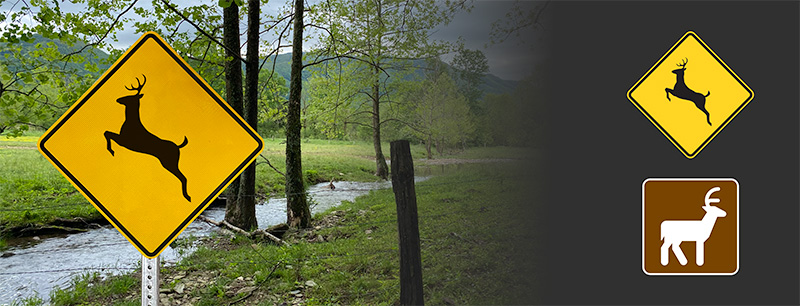Deer Crossing Signs FAQs

What are Deer Crossing Signs?
Deer Crossing Signs are used to warn drivers that deer are in the surrounding area. Deer are a potential road hazard, dangerous to both the driver and the animal, because they often enter the roadway quickly and without warning.
What do Deer Crossing Signs look like?
Deer Crossing Signs are yellow diamond-shaped signs with a thin black border. Each side of the diamond is the same length. In the center of the sign is a black silhouette of a deer jumping to the left—no text is used on this sign style.
What sign sizes do you offer, and which one should I use?
We offer four sizes of Deer Crossing Signs—24”x24”, 30”x30”, 36”x36”, and 48”x48”. Each size has distinct uses. 24”x24” signs meet the federal minimum but are not typically used on roadsides. 30”x30” signs are used on single-lane roads, while 36”x36” signs are used on multi-lane roads, interstates, and highways. Oversized 48”x48” signs are used in locations where drivers may not see smaller signs.
How do Deer Crossing Signs protect drivers?
Deer Crossing Signs warn drivers that they are entering an area known to have a deer population. Signs give drivers advance warning that deer may suddenly or unexpectedly run into the roadway.
What makes deer dangerous on the road?
Deer are dangerous road hazards for three main reasons: their gathering habits, their jumping ability, and their body weight and shape. First, deer are known to travel in herds, so oftentimes one deer on the roadside means there are many other deer in the area. In some cases, a large number of deer may attempt to travel across the road at once, and their appearance on the road can be sudden, unexpected, and dangerous. Second, many deer species, such as the common white-tailed deer, have the ability to jump over fences and other barriers that are up to 8 ft. tall[1]. Roadside fencing is largely effective in keeping smaller animals away from the road but is often ineffective in keeping deer away. Third, deer are exceptionally heavy and pose a greater risk than what might be expected. Adult male white-tailed deer weigh an average of 203 lbs.[2] and have large, bony antlers that could potentially pierce a vehicle’s windshield upon impact.
What other signs are used with Deer Crossing Signs?
The most important sign style used with Deer Crossing Signs are distance placards. Placards are typically placed below Deer Crossing Signs and give drivers additional information about potential deer appearances. For instance, a placard that reads “Next 25 Miles” notifies drivers that they should look out for deer over the next 25 miles.
Where do you see Deer Crossing Signs?
Deer Crossing Signs are commonly seen in rural areas. Signs often have fluorescent yellow, full-cube prismatic sheeting for additional low-light and nighttime visibility. Occasionally, signs also appear near forested urban areas.
How are Deer Crossing Signs mounted?
24”x24”, 30”x30”, and 36”x36 Deer Crossing Signs arrive with two pre-drilled holes, one hole at the top and one hole at the bottom, and can be mounted onto one sign post. 48”x48” signs have four pre-drilled holes and are mounted using two sign posts.
[1] Fact Sheet. Living with Deer. Georgia Department of Natural Resources’ Wildlife Resources Division.
[2] Article. White-tailed Deer. State University of New York College of Environmental Science and Forestry.
https://www.esf.edu/aec/adks/mammals/wtd.php